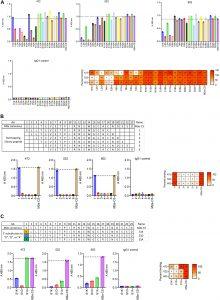Researchers have developed an antibody-based therapy that could transform how influenza is treated and prevented (Figure 1). In a study the team demonstrated that a cocktail of three antibodies protected mice, including immunocompromised animals, against nearly every influenza strain tested, from seasonal human variants to avian and swine viruses with pandemic potential.

Figure 1: Clones 472, 522, and 602 bind M2e in M2e’s highly conserved N-terminal region. Clones 472, 522, 602, all expressed as IgG1 isotypes, and IgG1 isotype-matched control mAbs were biotinylated for epitope mapping by ELISA. Corning 96-well EIA/RIA assay plates were coated with either (A) the M2e-CS peptide and corresponding alanine scanning peptides (2.5 μg/ml), (B) 18-mers of M2e-CS overlapping peptides, or (C) opposite or neutral charge M2e-CS peptides, in which the first amino acid serine (S) was substituted with lysine (K), aspartic acid (D), or alanine (A), as indicated, to confirm a requirement for the first amino acid (serine) for M2e-mAb binding. Serine (S) has a polar uncharged side chain, lysine (K) has a positively charged side chain, aspartic Acid (D) has a negatively charged side chain, and alanine (A) has a hydrophobic side chain. Then, the specified M2e-mAb clone (2.5 μg/ml) was used to determine the clone’s binding to the indicated peptide by ELISA. To calculate the percent binding for the heatmaps, the average binding—as determined by the absorbance at 450 nm (A 450 nm) of each M2e-mAb clone and with the isotype-matched control antibody-determined background subtracted—was used to calculate the percent binding as related to the consensus peptide sequence control, which was set as 100 percent. AA, amino acid.
Unlike existing FDA-approved flu antivirals, which target viral enzymes and often lose effectiveness as the virus mutates, this approach targeted a highly conserved region of the influenza A virus known as Matrix Protein 2 (M2e). Because M2e remains unchanged across strains, the therapy provided broad and durable protection. Notably, repeated viral exposure for almost a month did not produce escape mutations, underscoring its potential resilience against resistance.
The antibodies work in an unconventional way. Instead of neutralizing the virus directly, they are “non-neutralizing” antibodies that mark infected lung cells for immune clearance. While traditionally overlooked, these antibodies proved lifesaving: even mice infected with lethal H5 and H7 avian strains survived when treated, including when therapy was delayed several days after infection.
Protection was achieved with low doses, reducing viral load and improving survival rates in both healthy and immunocompromised animals. For H7N9 bird flu, a single dose given four days post-infection still reduced viral burden and increased survival, with full protection when treatment was started within the first three days.
The findings open the door to a stockpiled, “off-the-shelf” influenza therapeutic, one that could be deployed rapidly during seasonal outbreaks or pandemics, without the months-long lag required to update vaccines. If successful, this therapy could serve as both a prophylactic for high-risk populations, such as the elderly and immunocompromised, and as a treatment for severe influenza, reshaping global preparedness against one of the world’s deadliest infectious diseases
Journal article: Kim. T., et al. 2025. Non-neutralizing antibodies to influenza A matrix-protein-2-ectodomain are broadly effective therapeutics and resistant to viral escape mutations. Science Advances.
Summary by Stefan Botha










